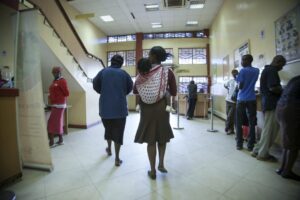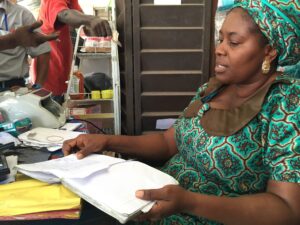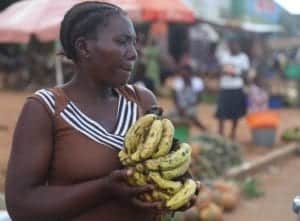Interested in our work in Africa? Visit the Africa page or explore our regional research.
Women’s World Banking, in partnership with Diamond Bank Plc (Nigeria) hosted a digital financial services workshop in Nigeria sharing best practices in designing products with women in mind among financial institutions leveraging digital technology to serve low-income women.
Many financial services providers miss the mark when it comes to serving women because their products and services are only superficially tailored to meet women’s needs. Avoiding gender-neutral approaches, using gender segmentation during research and product design and articulating a clear business case for this market are just some of the ways providers can avoid this trap.
Why don’t we need Facebook for Women? Because it already works for them.
Why don’t more women use financial products? Because they don’t work for them. And this is a problem, not just for the women who continue to be excluded but also for the financial institutions that neglect to make sure their offerings work for women. Why? Simple: because the biggest untapped market in the world is not China or India or any other country. It’s women.
Creating financial products with women in mind is not “pink-washing” products to make them superficially inviting to women, nor is it targeting products exclusively for women. Financial inclusion is growing yet the global gender gap has not budged, and this is because many financial products simply don’t work for women. So how can institutions close the gap and tap into this rich and overlooked market, to design products that include women?
Three elements of gender-inclusive design
Going beyond “gender-neutral”
Many believe that financial products are “gender-neutral” since they are open to both men and women. What financial institutions often don’t realize is that “neutral” products were often designed with men’s needs in mind — and unintentionally put women off. The reverse is not true, however: when products are created with women’s specific needs in mind, the data proves that men are just as or even more interested.

Women want to know: Will this product actually work for me? Are there barriers that prevent me from accessing this product? If I sign up, will I be able to get help if I need it?
As the head of retail banking at Kenya Commercial Bank (KCB) puts it: “Women are demanding. If you meet women’s needs, you will exceed men’s expectations.” This is where women-focused design comes in.
Segmenting by gender during the product design phase
Listening to women is key to taking their needs into account during the design phase. Segmenting by gender in research makes this possible, as women are less likely to speak up or voice a different opinion during research sessions where men are also present. They often have different concerns than men, for example they are cost-conscious and may face issues of affordability and access that men don’t.
Developing the business case for serving women
 Forward-thinking financial institutions are beginning to recognize the potential of the women’s market as a business growth strategy. To reap the rewards, they will need to believe in gender-inclusive products as a smart business move and not just as a Corporate Social Responsibility initiative. Institutions can continue to build this business case by monitoring the uptake of new gender-inclusive products and understand the impact of women clients on their bottom-line. This helps them learn from missteps and develop even stronger products that can reach scale and better capitalize on this market opportunity.
Forward-thinking financial institutions are beginning to recognize the potential of the women’s market as a business growth strategy. To reap the rewards, they will need to believe in gender-inclusive products as a smart business move and not just as a Corporate Social Responsibility initiative. Institutions can continue to build this business case by monitoring the uptake of new gender-inclusive products and understand the impact of women clients on their bottom-line. This helps them learn from missteps and develop even stronger products that can reach scale and better capitalize on this market opportunity.
Inclusive design goes to market
The following recent examples of Women’s World Banking’s partnerships with financial institutions in Africa demonstrate the value of designing financial products around women’s needs. They also highlight the importance of evaluating uptake among women and making necessary adjustments to reach them better.
In Malawi
Women’s World Banking worked with NBS Bank to design the Pafupi savings account, aimed at the large population of low-income women in rural areas. Our research showed that those women consider bank accounts aspirational but only available to rich people. Women are cost-conscious and keen aware that bank fees and transportation costs put banking out of reach for them. In response, Pafupi (which means “close to you”), allows small deposits, charges no monthly fees, and it operates through agents in conveniently located rural shops.
Even though Pafupi was designed specifically to address women’s needs, it initially attracted many more men than women. Only 30 percent of clients were women at first, even though women told us in focus groups that the product checked off all the right boxes. What we learned on closer inspection was that despite the gender-inclusive product design, the accounts weren’t meeting women’s needs in the sales and delivery phases. Developing additional sales channels to close these gaps, like enabling account opening at agent locations or via groups that have high participation of women, makes it possible to dramatically raised uptake by women.
In Nigeria
Similarly, we partnered with Diamond Bank to design the BETA proposition for low-income women entrepreneurs. The BETA concept was based on market research showing that Nigerian women are inherent savers, saving up to 60 percent of their money informally in savings groups or with savings collectors. They stay away from banks however, because fees, slow service, and lost income from leaving their businesses aren’t worth it for the amounts they save. BETA is a simple and affordable account that offers doorstep service through a network of mobile agents known as BETA Friends. BETA Friends open and service the accounts in markets near where women live and work, transacting digitally on mobile phones. BETA accounts have been a success since their 2013 launch, attracting more than 480,000 new customers to Diamond Bank.
In Kenya

If financial institutions worldwide rethink the way they reach out to women when launching new products, the growth opportunities will be boundless. Financial products that deliberately take women’s needs into account, at every step of the process, are a win-win-win: For women, for men, and not least of all for every institution that makes a strong, unwavering commitment to gender inclusion.



